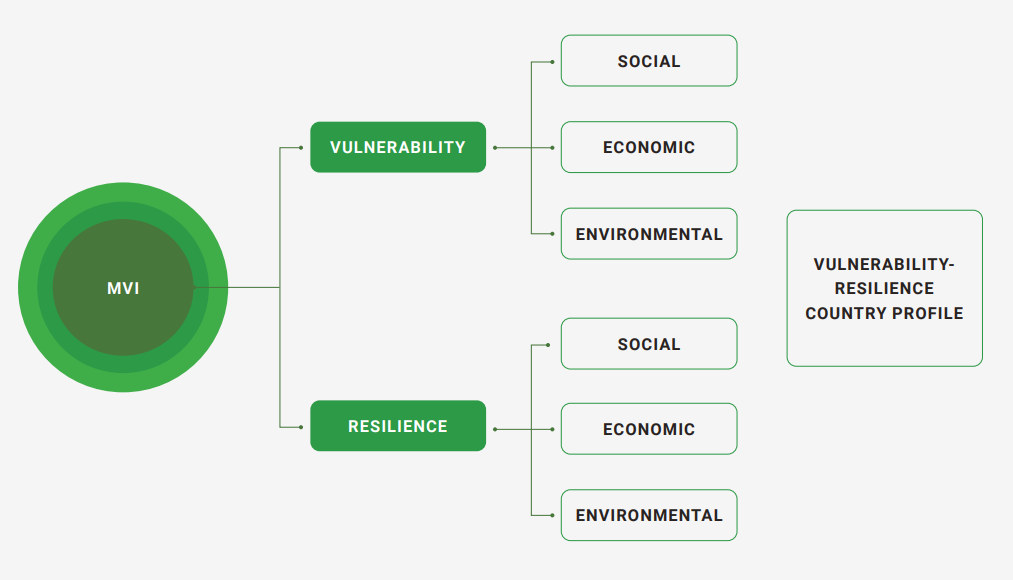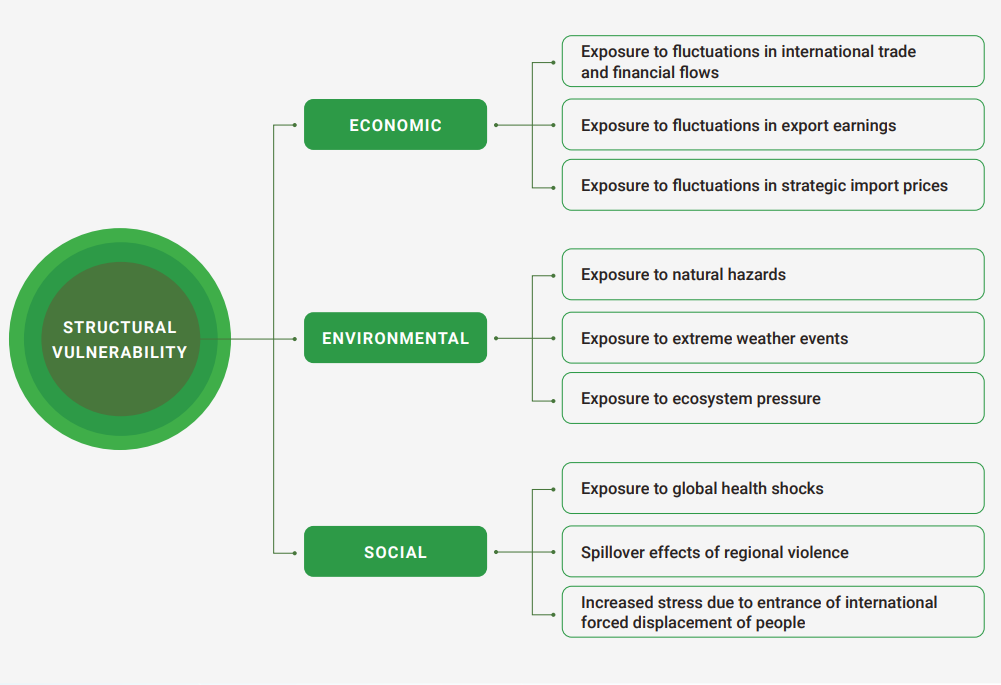Disaster Management
Multidimensional Vulnerability Index (MVI)
- 22 Aug 2024
- 7 min read
For Prelims: Multidimensional Vulnerability Index (MVI), Small Island Developing States (SIDS), GDP Per Capita, National Income, United Nations, International financial institutions (IFIs), Debt, MVI Secretariat, MVI Advisory Review Panel.
For Mains: Significance of Climate Financing for Building Resilience Against Climate Change Induced Disasters.
Why in News?
- The UN General Assembly launched the Multidimensional Vulnerability Index (MVI) to assist small island developing states (SIDS) in securing low-interest financing.
- Since the 1990s, SIDS that don't qualify for low-interest development loans due to their relatively higher GDP per capita have been advocating for a measure that accounts for their vulnerability to external shocks like climate change.
What is Multidimensional Vulnerability Index (MVI)?
- About: The MVI is a new international quantitative benchmark to measure structural vulnerability and the lack of structural resilience across multiple dimensions of sustainable development at the national level.
- It can be used to complement Gross National Income (GNI) per capita.
- Need of MVI:
- Current Limitations: National income, typically measured by Gross National Income per capita, is an inadequate indicator of development and well-being, especially for countries facing high risks of external shocks.
- Access to Concessional Financing: Countries often struggle to access affordable development support, such as concessional assistance, because eligibility is based on income thresholds rather than vulnerability.
- Inclusive Aid Allocation: A widely accepted MVI could better guide development policies, aid allocation, and provide early identification of nations requiring international assistance.
- Structure of the MVI: It incorporates two main components.
- Universal Level Quantitative Assessment: A summary index ranks countries based on their structural vulnerability and resilience using a common methodology. This is presented as an overall MVI score.
- Vulnerability-Resilience Country Profiles (VRCP): It is a more detailed, tailored, and individualised characterisation of a country’s vulnerability and resilience factors.
- Key Principles Guiding MVI Index Construction: It follows several guiding principles in construction of MVI.
- Multidimensionality: Indicators used should cover all three dimensions of sustainable development, i.e. economic, environmental, and social.
- Universality: The design of the index should capture the vulnerabilities of all developing countries to ensure credibility and comparability.
- Exogeneity: The index must clearly differentiate between policy-induced and exogenous (or inherited) factors to reflect the structural and inherent challenges faced by countries, independent of the political will of their governments.
- Availability: The index should use available, recognized, comparable, and reliable data.
- Readability: The design of the index should be clear and easily comprehensible.
- Conceptual Framework for the MVI: The MVI is built on two main pillars.
- Structural Vulnerability: It is linked to a country’s exposure to adverse external shocks and stressors.
- Structural Resilience: The capacity of a country to withstand and recover from such shocks.
- The conceptual framework elaborates the three dimensions of sustainable development i.e., economic, environmental, and social as they apply to each pillar:
- Economic Vulnerability: Risk from adverse external economic shocks.
- Environmental Vulnerability: Risk from natural hazards, climate change, and anthropogenic shocks.
- Social Vulnerability: Risk from social shocks.
- Structural Economic Resilience: The inherent economic capabilities and capital that strengthen a country’s ability to recover.
- Structural Environmental Resilience: The inherent environmental capital, including ecological resources and infrastructure, that reduces vulnerability.
- Structural Social Resilience: The inherent social capabilities, including social cohesion and human capital, that enhance adaptive capacity.
- Indicator Selection and Index Construction: The MVI Panel chose highest-quality indicators, using available United Nations data. They combined these indicators into a single vulnerability metric through rescaling, aggregation, and weighting.
- Key Observations by MVI Panel:
- Correlation: Countries with high structural vulnerability tend to have low structural resilience.
- Income Independence: MVI scores are not correlated with income, making it a valuable complement to GNI.
- Small Island Developing States (SIDS): The MVI does not discriminate against small countries, 70% of SIDS score above the median.
- Ranking and Thresholds: The majority of countries are moderately vulnerable. As a result, it is difficult to establish a vulnerability threshold or cutoff similar to the income cutoffs commonly used to allocate development aid.
- Key Observations by MVI Panel:
- Recommended Use of MVI:
- Incorporation by Donors: Donors, including international financial institutions (IFIs), should be encouraged to explore how the MVI could be incorporated into existing policies and practices, pursuing a common approach to the extent possible.
- Debt Assessment: Assessment of country external debt sustainability and the need for concessional debt restructuring could use the MVI, in addition to current, mostly income-based, assessments.
Conclusion
The Multidimensional Vulnerability Index represents a critical step forward in addressing the complex challenges faced by vulnerable countries. By providing a comprehensive, multidimensional assessment of vulnerability and resilience, the MVI has the potential to reshape global development policies and ensure that assistance is directed to where it is most needed.
|
Drishti Mains Question: Q. Financing climate change induced disasters has become imperative for low income countries (LICs) and small island developing states (SIDS). In this context discuss how the recently launched Multidimensional Vulnerability Index can help LICs and SIDS. |
UPSC Civil Services Examination, Previous Year Questions (PYQs)
Mains:
Q.Describe various measures taken in India for Disaster Risk Reduction (DRR) before and after signing ‘Sendai Framework for DRR (2015-30)’. How is this framework different from ‘Hyogo Framework for Action, 2005’? (2018)
Q.How important are vulnerability and risk assessment for pre-disaster management? As an administrator, what are the key areas that you would focus on in a Disaster Management System? (2013)






